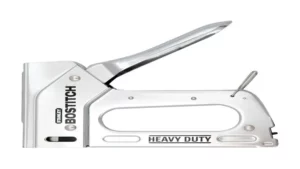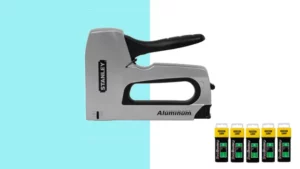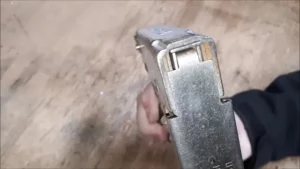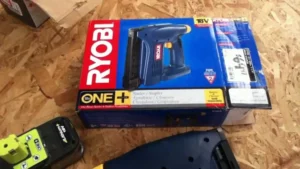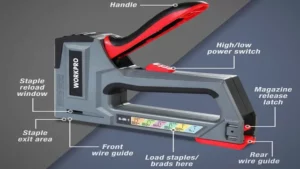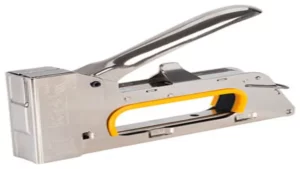Have you ever wondered how a staple gun works? Whether you’re an avid DIY enthusiast or a professional carpenter, staple guns are a staple (pun intended) tool in any workspace. However, while we may use them regularly, few of us understand the intricate mechanism behind their function. In essence, a staple gun operates similarly to a hammer, but instead of driving nails into wood, it drives staples into materials like fabric, cardboard, and wood.
When you press down on the trigger, a spring mechanism in the gun drives a bar forward, which then drives a staple into the material. It’s a simple yet effective process that allows us to secure materials together quickly and efficiently. But that’s not all there is to a staple gun.
Different guns have different strength settings that allow for staples of various sizes to be used, depending on the material being stapled. There are also different types of staple guns, including manual, electric, and pneumatic, which all operate with varying degrees of force and speed. In this blog, we’ll explore the inner workings of a staple gun and explain the different types and uses of these essential tools.
Whether you’re a beginner or a seasoned pro, understanding the mechanics behind a staple gun can help you make informed decisions when purchasing one and using it effectively.
Introduction
Have you ever wondered how a staple gun works? Well, it’s actually quite simple. A staple gun typically works by using compressed air, electricity, or a spring-loaded mechanism to drive metal staples into a surface. The metal staples are typically made of thin wire and come in a variety of sizes and shapes to suit different applications.
When the staple gun is fired, the staple is driven into the surface, securing the materials together. The staple gun’s strength and depth of penetration depend on the type of staple used, as well as the power of the mechanism used to drive the staple. Whether you’re looking to secure your roof shingles or upholster a chair, a staple gun is an essential tool in any DIY toolkit.
So, the next time you use one, you’ll know how it works and can use it with confidence.
Definition of a Staple Gun
A staple gun is a handheld tool that helps fasten materials together using staples. These staples are typically small, U-shaped metal pieces that are initially loaded into the staple gun and then fired with a squeeze of the trigger. Staple guns come in various sizes and styles that are suitable for specific projects.
From crafting to woodworking, a staple gun is a versatile tool that can attach fabric, cardboard, paper, and even thin sheets of metal. It’s an essential item in any DIY toolbox and can save you time and effort compared to using a traditional stapler. So, whether you are a professional or a hobbyist, investing in a high-quality staple gun can make your projects more efficient and professional-looking.
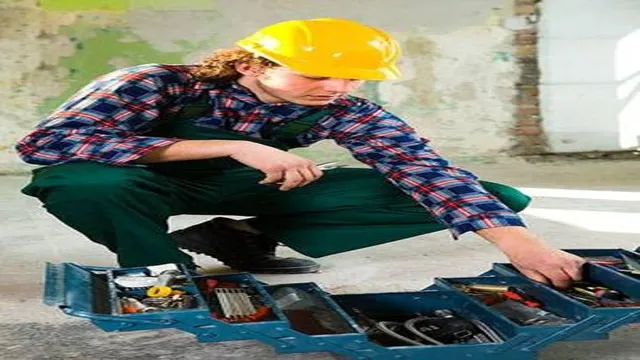
Types of Staple Guns
Staple guns are versatile tools used for attaching materials together by driving metal staples into the surface. They are available in several types, each designed to suit a particular application. The most common types include manual, electric, and pneumatic staple guns.
Manual staple guns are affordable and easy to use, making them ideal for small DIY projects around the house. Electric staple guns are more powerful and come in corded and cordless models, making them perfect for larger projects like upholstery. Pneumatic staple guns use air pressure to drive the staples, making them the most powerful and efficient option for commercial and industrial use.
Each type of staple gun has its pros and cons, so you should choose one that suits your particular needs and budget. Regardless of the type, staple guns are an essential tool for anyone looking to undertake DIY projects or professional jobs.
Staple Gun Anatomy
If you’ve ever needed to affix paper, fabric, wood, or other materials together, you’ve likely used a staple gun. But have you ever wondered how a staple gun actually works? It all starts with the staple gun’s anatomy. At the front of a staple gun is its “nose,” or the part that touches the material to be stapled.
Behind it is the “magazine,” which holds the staples in place. When you squeeze the trigger, a spring-loaded pusher advances a staple from the magazine towards the nose. At the same time, a blade pushes up against the staple, bending its legs inward and securing it to the material.
This all happens in a split second, allowing for quick and easy fastening. So, the next time you use a staple gun to put up posters or upholster a chair, take a moment to appreciate the mechanics at work – and always be sure to handle the gun with care!
Parts of a Staple Gun
A staple gun is a useful tool that is used to fasten materials together quickly and easily. The anatomy of a staple gun is relatively straightforward, consisting of a few key parts that are essential for its proper operation. At the front end of the gun is the muzzle, which is the opening through which the staples are ejected.
The staple cartridge is the part of the gun that holds the staples, and it is usually located just behind the muzzle. The magazine is the spring-loaded section of the gun that pushes the staples out of the cartridge and into the muzzle. The handle of the gun is where the user grips the tool, and it typically has a trigger or lever that activates the firing mechanism.
Finally, the mechanism that actually drives the staples into the material is located directly behind the muzzle and is comprised of a spring-loaded plunger and a drive plate. Keeping these parts in good working condition is crucial for maintaining the efficacy of a staple gun and ensuring that it functions properly every time.
How the Trigger Works
The trigger on a staple gun works like a miniature spring-loaded lever that creates tension and releases it in a burst of force when squeezed. The anatomy of a staple gun is relatively simple; the trigger is a small, spring-loaded mechanism that connects to the stapling mechanism which houses the staple strip and anvil. When the trigger is squeezed, the spring is compressed, and as it releases, the mechanism provides the force to drive the staple into the material.
This process creates a satisfying “click” sound, letting users know that the staple has been properly positioned and the trigger mechanism has been reset. It’s important to note that different staple guns work in slightly different ways, and so the trigger mechanism may vary depending on the specific model and brand. Nevertheless, whether for crafting, upholstery, or construction, staple guns continue to be an indispensable tool for those in need of speedy and efficient fastening.
Staple Chamber and Loading Mechanism
A staple gun is a versatile tool used for a plethora of tasks, like fastening papers, securing fabric, or fixing wooden frames. Understanding the anatomy of a staple gun is vital before using them. The staple chamber and loading mechanism are two crucial parts of a staple gun.
The staple chamber stores the staples, and the loading mechanism is responsible for pushing the staples into the staple chamber. It is important to note that different models of staple guns have different loading mechanisms, so make sure to refer to the instruction manual before loading the gun. Some staple guns require pushing the staples into the chamber manually, while others have a spring-loaded mechanism for effortless loading.
Additionally, the staple chamber size varies based on the type of staple gun, make sure to choose the correct size of staples that match your staple gun’s make and model. Always keep the staple gun’s staple chamber clean and free of debris to avoid jam and malfunctioning.
Staple Gun Operation
If you’re wondering how a staple gun works, it’s actually quite simple. A staple gun uses mechanical force to push a staple through a material, such as paper or a wooden board. When the trigger of the staple gun is squeezed, the spring-loaded baseplate forces the staple strip forward.
This causes the staple to be pushed out and through the material, and the ends of the staple are bent inward to hold the material together. The key to using a staple gun is to make sure the material being stapled is held firmly in place, as a staple gun can generate a lot of force. It’s also important to ensure that the correct size and type of staple is being used for the material being stapled.
Now that you know how a staple gun works, you can use it to tackle all kinds of projects, from simple office tasks to more complex DIY projects.
Step-by-Step Instructions for Staple Gun Use
Staple guns can be incredibly useful tools, but they can also be intimidating to use if you’re not familiar with them. Luckily, the process of using a staple gun is fairly simple once you know what to do. First, make sure your staple gun is loaded with the right kind of staples for your project.
Then, hold the gun against the surface where you want to place the staple and press down firmly. You should hear a satisfying “click” as the staple is secured in place. Repeat this process as needed to finish your project.
It’s important to be careful when using a staple gun, as the staples can be sharp and potentially dangerous. Keep your fingers clear of the staple exit point and always wear eye protection while using the gun. By following these simple steps, you’ll be able to tackle all kinds of projects with a staple gun in no time!
Safety Tips for Staple Gun Use
When it comes to using a staple gun, safety should always be your top priority. Before you start operating the tool, make sure to read the instructions manual carefully to familiarize yourself with its features and functions. Always wear safety goggles and protective gloves to prevent any potential injuries.
Avoid pointing the staple gun at anyone, especially when you’re working in a crowded area. Additionally, make sure to keep your fingers clear of the firing area and never try to remove stuck staples with your bare hands. Instead, use a pair of pliers or another tool to pry them loose.
Remember, a staple gun can be a useful and effective tool, but it can also be dangerous if not used correctly. So, take your time, use caution, and always prioritize safety.
Conclusion
In conclusion, staple guns are the perfect blend of simplicity and ingenuity. They work by using a spring-powered mechanism to drive a metal staple into whatever you’re stapling, be it plywood, cardboard, or even a stubborn piece of fabric. With just a little bit of pressure from your hand, the staple gun can transform your project from flimsy and unstable to strong and durable in mere seconds.
It’s like having a tiny superhero in your toolbox, ready to save the day with a swift shot of its trusty staple. So the next time you need to fasten something securely, just remember to let the staple gun do the heavy lifting. Your project, and your fingers, will thank you!”
FAQs
What is a staple gun and how does it differ from a traditional stapler?
A staple gun is a handheld tool that is used to fasten materials together with staples, which are typically made of metal. Unlike a traditional stapler, which is generally used for lighter-duty tasks, a staple gun is capable of handling heavy-duty tasks and can fire staples into thick materials such as wood, metal, and plastic.
How does a staple gun actually work?
When a staple gun is pressed against a surface, a trigger mechanism fires a staple from the staple magazine, which is typically located on the top or bottom of the tool. The staple is then driven into the material with significant force, thanks to a spring-powered mechanism that compresses as the trigger is pulled.
What are some common uses for a staple gun?
Staple guns are commonly used in a variety of applications, such as carpentry, woodworking, upholstery, and even automotive repair. Essentially, any type of task that requires fastening one material to another can potentially be done with a staple gun.
Can a staple gun be used on delicate materials like fabrics?
It depends on the specific staple gun and the size of the staples being used. Many staple guns come with adjustable depth settings that allow you to fine-tune the force with which the staples are fired, making them suitable for use on delicate materials like fabrics or thin plastics.
Do different types of staple guns use different types of staples?
Yes, staple guns come in several different types, including manual, electric, and pneumatic (air-powered) models. Each type may use different sizes and types of staples, so it’s important to choose the right tool for the job.
Are there any safety considerations when using a staple gun?
Yes, staple guns can be dangerous if not used properly. Always read the manual before use, wear safety glasses, and make sure to keep your fingers away from the staple path. Never point the staple gun at yourself or anyone else, and always keep the staple gun unloaded when not in use.
How can I maintain my staple gun to ensure it lasts as long as possible?
Regular maintenance is key to keeping your staple gun in good working condition. This may include cleaning the tool after each use, oiling the internal mechanism, and storing the tool in a dry, protected area. Be sure to follow the manufacturer’s instructions for specific maintenance procedures.

